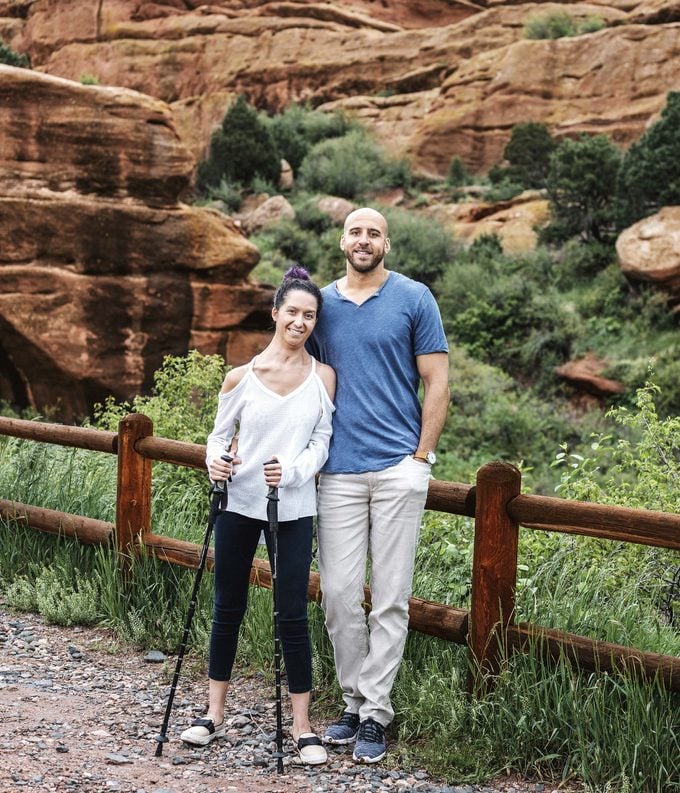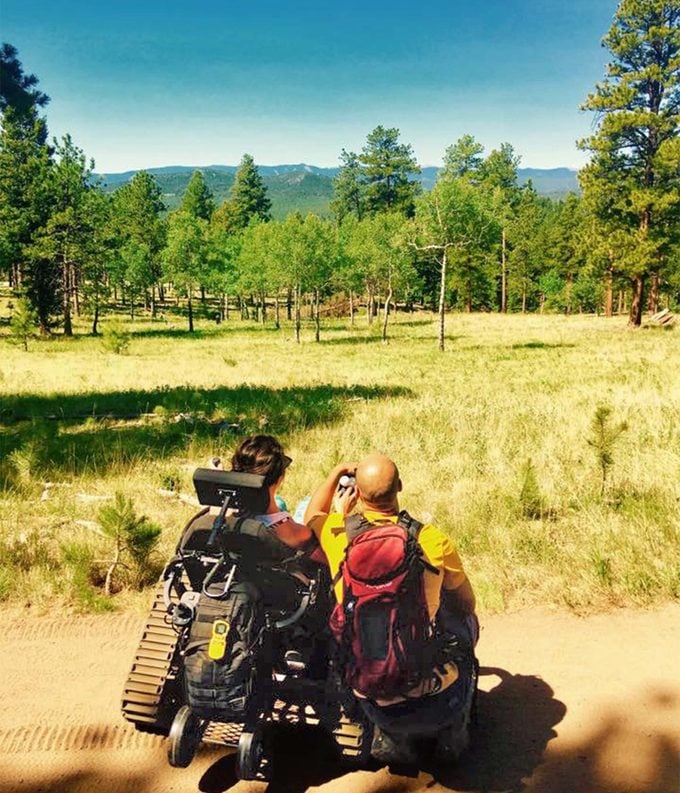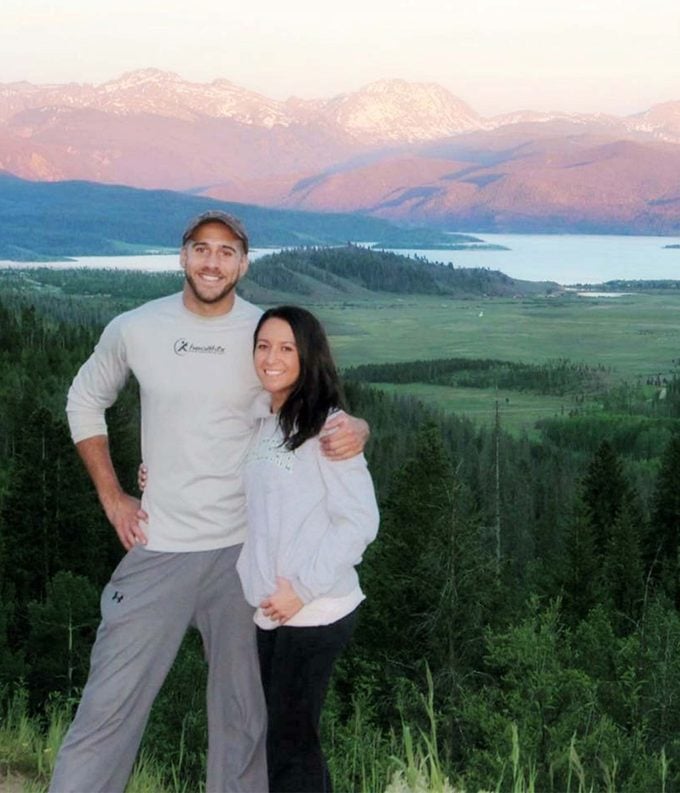After a Horrible Car Crash, Her Odds of Survival Were Just 100 to One
Updated: Jun. 30, 2022
A car crash left Molei Wright functionally decapitated. Even if her body survived, her mind might never be the same.

The snow came earlier than they’d expected, but Jeremy Osheim wasn’t worried. He’d driven this route a thousand times, and he knew exactly what to do. Take it easy. Watch the road. You’ll get there when you get there, and when you do, it’s gonna be awesome.
It was January 2016, and Jeremy and his girlfriend, Molei Wright, were leaving Denver for a weekend of fun with friends on the slopes in Breckenridge, Colorado. They were two like-minded Colorado natives: ambitious, gregarious, and thoughtful, both lovers of books, plays, music, the outdoors. Jeremy, then 29, was a public relations specialist who moonlighted as a mixed martial arts fighter; Molei (pronounced “Molly”), then 28, was the first in her family to graduate from college and worked selling mutual funds to financial advisers. They’d been together for less than a year, but it had taken only a few dates to realize that they clicked. They’d never formally professed their love for each other, but Jeremy was pretty sure that Molei was the one. As the car began the twisting climb toward the resort town, Jeremy felt an overwhelming wave of gratitude.
The odds were 100 to one
“Life was really great,” he says. “Probably the best moment of my life, just feeling so good about what was ahead for us. Then, within a blink of an eye, everything was shattered.”
The truck that hit them came out of nowhere. One minute, Jeremy’s Mitsubishi Montero was rolling smoothly through the falling snow; the next, he was sitting by the side of the road in a mangled SUV, pinned to his seat by the steering wheel, his body screaming with pain. To his right he saw Molei. Her eyes were open, but Jeremy could tell they saw nothing. He could think of only one thing to say: “Don’t die. I love you. Don’t die …”
Statistically, she should have died. Inside her neck, Molei’s vertebrae had basically been crushed. Her head was attached to her shoulders by nothing but skin and muscle. Doctors call it cervical occipital dislocation. The more common description is internal decapitation. The odds of survival: a hundred to one.
Henry Rodriquez, a vacationing Army lieutenant trained in emergency medicine, was driving on the same highway not far behind the Mitsubishi and pulled over instantly when he saw the wreck.
While his wife calmed the trapped and terrified Jeremy, Rodriquez worked swiftly. One wrong move could have left Molei dead or paralyzed. Protecting her head and neck, he carefully extracted her from the twisted wreckage—“scrap metal,” he said at the time—and laid her on the road by the side of the car, covering her with coats to keep her warm.
She’s a fighter
For 45 harrowing minutes, as snow whirled down from the ink black sky, Rodriquez pounded her chest to bring her heart back to life. As the ambulance rushed to her, she showed flickers of consciousness and movement. Those signs would soon be gone. The fact that she made it to Lakewood’s St. Anthony Hospital alive was a miracle.
By the time her mother, Mo Wright, finally saw her, Molei had sunk into a coma and was hooked up to a half-dozen tubes and machines. The doctors could tell Mo almost nothing beyond the obvious: It was extremely serious. At any moment, fever, infection—anything—could carry her off. And even if her body stabilized, her brain might never recover.
“One doctor took me aside and said, ‘I need to be honest. There’s a chance she’s not going to make this,’” says Mo. “And I remember saying, ‘Molei is a fighter. She’s competitive. She’s not one to just lie back and take this.’”
But doctors knew it might not be up to Molei. In addition to her shattered neck, Molei had suffered fractures in her ribs and other vertebrae, bruises on her lungs, and damage to the major arteries bringing blood to her brain. Scans showed what Philip Yarnell, MD, a trauma neurologist since 1967, called multifocal shearing injury inside her skull—hemorrhages all across the surface, blood vessels, and brain stem.

Letting the brain heal
Like anyone who has suffered a traumatic brain injury, she’d entered a realm of mystery. How well a given mind recovers is completely unpredictable. In fact, doctors have a saying: If you’ve seen one brain injury, you’ve seen one brain injury. Sometimes victims come back fully capable and healthy. Sometimes they linger forever in the twilight of consciousness.
And sometimes their brains survive but their personalities don’t. “They get angry, they have temper problems, their families are afraid to be around them,” says Dr. Yarnell. Such cases can be devastating, shattering relationships and ending marriages. “You’re with one person, and then you’re with another, and it’s not the one you started with.”
Dr. Yarnell knew the Wright family would want answers. But he knew that only time would tell the full story.
“You don’t give a long-term prognosis,” he says. “You can be fooled.”
So as Molei lay silent and still, the best the doctors could do to save her brain was to save her body: Drugs to fend off fevers and infections. Machines for food and oxygen. Surgeries for injuries. Constant monitoring for signs of consciousness. And above all, patience.
“We don’t have a medicine to make the brain heal,” Dr. Yarnell says. “We try to let the brain heal by itself.”

Looking for signs
In the weeks after the crash, a pattern set in. Molei lay in her bed being fed through a tube, breathing on a ventilator. Dr. Yarnell and his team would come in every day to test her reactions and see whether her brain was responding. Poke her arms and feet. Pinch her shoulders. Move objects in front of her face to see whether her eyes would track them.
But as the doctor’s log documented, Molei showed little reaction:
February 6:
Not following commands
February 11:
Not following commands
February 15:
Not following commands
“It was killing us,” Mo says. “Every morning I would get in the car and drive to the hospital, and every morning was my lowest moment … What are they going to tell us?”
Jeremy, who by now had recovered from his own serious injuries—a broken hip and scapula, as well as heart and lung contusions—followed the nurses’ cues and talked to Molei as if she could hear him, clinging to the slender hope Dr. Yarnell had given them: that she could recover.
“I just kept thinking, She’s going to come back to me. I know it, I know it,” he says.
Signs of life
But with every passing day, Jeremy also knew that Molei’s chances of recovery grew worse. At one point, her wrists and hands started to curl inward, a phenomenon called posturing that can indicate serious irreversible regression.
“I was heartbroken,” says Jeremy.
And then, about three weeks after the crash, Molei began to show signs of life.
February 25:
Moving the right leg spontaneously
February 29:
A focused gaze
March 1:
Off the ventilator all day. Looks to both sides
The signs were tiny—sometimes so tiny that only Dr. Yarnell could see them.
But they were enough. Somebody was in there. But was it Molei? (Read the story of how after one boy’s skull was crushed in a car accident, doctors thought recovery was hopeless—but they were wrong.)

Helping and hoping
Molei can still remember seeing the date on the whiteboard at the foot of her bed and realizing that three full months of her life had disappeared.
“It said, ‘Hello, Molei! Today is Wednesday, May 18,’” she says. “It was confusing … like, Wait! What happened to February and March and April?”
Molei didn’t know it, but she was now in Craig Hospital in Englewood, one of the nation’s leading rehabilitation centers for brain and spinal injuries. Three months after the crash, Dr. Yarnell had seen enough consistent response to get Molei admitted to Craig. There, therapists worked to revive her with regimens of wake-up drugs and physical therapy.
Molei was largely in a fog the first several weeks after coming to. She knew she was still Molei, but she also knew she couldn’t connect with staff or even loved ones, and she didn’t know whether she ever would.
And then one day, Jeremy made her laugh. It happened in the workout room at Craig. Jeremy had taken her there himself.
By this point, Molei was in a sort of half-conscious limbo. She couldn’t direct her own movements or talk. But if Jeremy or her therapists moved her limbs, she could sit up and even stand. That day, Jeremy was doing just what he’d been doing for weeks: helping and hoping.
First he hoisted her from the bed and onto a kind of hanging chair that moved on tracks, which in turn took her to a wheelchair. From there, it was down to a room full of padded platforms designed for massage and therapy. His plan was to stretch her limbs a bit while he talked to her. So he laid her on the therapy bed, sat at her feet, and started flexing her legs, chattering and spouting, as he called it, “nonsense,” just as he’d been doing for months.
He wasn’t surprised when Molei’s body suddenly spasmed and she sat up abruptly. Without even thinking, Jeremy responded, “Hey, we’re not doing sit-ups. What are you doing?”
And she laughed.
Jeremy’s eyes lit up. “Oh my God!” he shouted. “You hear me! You’re in there!”

Learning all over again
It was a watershed moment. “I don’t know if I’ve ever laughed so much or smiled so hard,” he says. “I knew then that she knew who I was. She thought my stupid jokes were funny still. She knew who I was.”
It was a breakthrough for Molei as well. “The way he laughed back, I just knew,” she says. “He could tell, ‘Hey, she’s still in there!’ I’m not just this girl in a coma.”
In the weeks that followed, Molei improved dramatically. Soon she was watching, listening, focusing, and responding.
She still couldn’t talk, so she tried to communicate using the sign language she’d learned in college. Jeremy knew some sign language, too, so he understood the first thing she told him.
“It was, ‘I love you,’” Molei said. “That’s the first thing I said to him.”
Molei had spent a total of six months in hospitals after the crash, including two months at Craig, where she learned to eat (carefully), talk (slowly), and walk short distances with a walker. Cognitive rehabilitation therapy—puzzles, tests, medication for focus and attention—had helped her mind come back to life. The brain is a remarkable thing, Dr. Yarnell often says. If you keep exercising it, it can find all sorts of ways to work around its problems.
So when the doctors said she was ready, she moved back to her family’s home. There were setbacks and frustrations; the simplest decision, such as whether to use the walker or the wheelchair to get to the living room, could be fraught with stress or danger. But every month, Molei made progress. And eventually, once again, the everyday became the norm: using the bathroom, folding laundry, riding the exercise bike. As her body revived, her mind sharpened, just as Dr. Yarnell had predicted.
Conquering the mountain
In what may have been her biggest step of all, Molei moved in with Jeremy, 18 months after the crash. The life they’d once imagined sharing began to take shape. And even if it isn’t exactly the life they’d expected, Jeremy says, the love they share is just as deep—maybe deeper.
“I liken it to going to war with someone,” says Jeremy. “We went through something that is unfathomable to other people. I shared some things with her that I can’t quite explain.”
Today, Molei Wright still faces her share of challenges. Her left side is still weak, her grip uncertain; her fused spine means she can’t turn her neck. Dr. Yarnell says Molei will probably always have some cognitive deficits. Multitasking will tire her out. Holding down a high-stress job might never be possible.
And yet she now manages the couple’s household along with her own recovery. She meets with friends, shares books and podcasts with Jeremy, and volunteers to visit classrooms and talk to students. She’s training for a bike race. She’s considering a new career as an occupational therapist.
She’s the Molei Jeremy fell in love with, the one who’d never settle for anything less than the best. “You just can’t turn off this wild ambition,” he says. “You can’t go through something like this and be exactly the same person, but the core of who she is is the exact same.”
Two years after she and Jeremy almost died in the snow driving to Breckenridge, Molei finally arrived at the resort town. Using outriggers (poles with skis on them), she skied down the mountain, plowing through the snow as the trees blurred by and her cheeks tingled in the delicious crisp air.
She wasn’t a crash victim anymore. She was just Molei Wright, out in the sun with the man she loved, conquering the mountain she’d first set out to run two years earlier.
Next, find out the secrets your brain wishes you knew.


